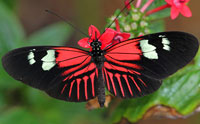Listen Now. On this episode of ID the Future, David Klinghoffer announces Discovery Institute’s 2013 Censor of the Year award. Listen in as Klinghoffer explains why we’ve chosen to recognize University of Chicago biologist Jerry Coyne, out of several promising nominees, for his success in choking off free speech on intelligent design and evolution.
“Another incredible marvel of design that only an intelligence far greater than ours could have produced.” Admin Human eyes are well-designed to see objects using light transmitted through air, but not through water, because light travels at a different speed through the two media. However, intertidal-dwelling marine mollusks called chitons can see equally well in both environments. How did they acquire this unusual ability? Chitons scour intertidal rocks for algae meals. Eight integrated shell-plates cover their backs, and a muscular foot allows them to cling with surprising strength to the rocks they traverse. A recent study explored their unique dual-mode [More]
The important Ben Stein movie Expelled: No Intelligence Allowed, has certainly helped to put “intelligent design” (ID) in the spotlight. Taking advantage of this interest in ID, CMI carried out several “design” tours in various countries in 2008. CMI’s Creation magazine has for decades included articles about design. CMI’s Dr Jonathan Sarfati is the author of the best selling creation book ever written—Refuting Evolution. His newest book is By Design, a comprehensive creationist book on the subject of design. As Expelled shows, ID is really a subset of the broader “origins” controversy. It is limited to simply opposing the notion [More]
By Creation Moments There seems to be no end to the variety and wisdom of design in the creation. Most interesting are those creatures that share important traits and yet are nothing like each other. The whale is one example; it is constructed like a fish but is really a mammal. read more …read more Read more here: Creation Moments
By Creation Moments Aphids are tiny creatures that are often tended – even protected – by ants. Like many creatures, aphids provide a wonderful testimony to God’s ability to create endless variations on a theme. read more …read more Read more here: Creation Moments
By Creation Moments School textbooks continue to claim that man is the only animal to use tools. Of course, speaking this way not only identifies man as merely another animal but also completely ignores the fact that man was made in the image of God and, thus, has moral responsibilities. However, using this “man the tool-user” argument to support evolution has been quietly shot down as science continues to discover a growing number of animal tool-users. read more …read more Read more here: Creation Moments
By Creation Moments We all like to live at a comfortable temperature. Excavations from the most ancient human sites show that homes and entire cities were often positioned to catch the prevailing winds in the summer or to avoid cold blasts in the winter. read more …read more Read more here: Creation Moments
Birds flying in V formation take aeronautical engineering to new heights. …read more Read more here: AIG Daily
The lowly, ‘basal’ box jellyfish has astonished scientists with its capacity to see things above the water. …read more Read more here: creation.com
By Creation Moments Did you ever stand up a little too quickly and get dizzy? It can happen because by standing, you may have temporarily lowered the blood pressure in your brain. Can you imagine what might happen when the giraffe swings its head from the ground to a treetop? read more …read more Read more here: Creation Moments
For the amazing echolocation ability of bats to function properly, both emitting and receiving organs must be present, and cooperate. (There are other problems too, to drive evolutionists ‘batty’.) …read more Read more here: creation.com
By Creation Moments In 1835, when scientists first saw Peru’s most unusual hummingbird, they were so overcome with its beauty that they gave it the name “Marvellous”. read more …read more Read more here: Creation Moments
“One of the scientists quoted in the article states “We’ve got some catching up to do.….The nature-produced tiny structures are far beyond any human designs.” yet evolutionists want us to believe this marvel of design happened by chance … ridiculous.” Admin The diamond weevil, which makes its home in the Brazilian tropics, has a body studded with tiny, brilliant reflectors. Each one is like a diamond, reflecting different-colored light in shiny arrays. New research has probed the microstructure of these brilliant facets and discovered that the way they work is familiar—but the way they are made is not. These insect [More]
“Once again man is copying one of the marvels of design in Gods creation.” Admin Harvard’s Wyss Institute specializes in designing new materials and devices that mimic patterns found in living things. Their latest contribution was inspired by the versatile material found in insect cuticle, which is strong and flexible, yet remarkably lightweight. The result was “shrilk,” a moldable, biodegradable substance derived from shrimp shells and silk that is as strong as some aluminum alloys but only half their weight. “Shrilk could be used to make trash bags, packaging, and diapers that degrade quickly,” according to a Wyss Institute press [More]
Listen Now. On this episode of ID the Future, brain surgeon and ID blogger Michael Egnor talks with CSC Research Coordinator Casey Luskin about his internet debates with Jerry Coyne and the trends and dynamics he sees in the ID/evolution blogosphere. Dr. Egnor also speaks briefly on the evidence he sees for intelligent design in the brain. Dr. Michael Egnor is a Professor in the Department of Neurosurgery at The State University of New York at Stony Brook, where he specializes in Pediatric Neuroscience. An award-winning neurosurgeon and a widely-published researcher, Dr. Egnor writes regularly at Evolution News & [More]
“The honeybee’s guidance system and waggle dance it does to communicate to other bees how to get to the nectar are complex marvels of design. Another testimony to God’s handiwork.” Admin Polarized light imprints GPS directions on the honeybee brain’s genes. The uncanny ability of honeybees to remember and communicate the location of sweet nectar has been the subject of ongoing investigations—both navigational and genetic. “The more we find out how honeybees make their way around the landscape, the more awed we feel at the elegant way they solve very complicated problems of navigation that would floor most people—and then [More]
“If man with all his ingenuity can only create a much inferior fake Jellyfish then what is the probability that blind random chance could create the much superior real one, I think we know the answer to that.” Admin Many jellyfish are transparent, and they have seemingly simple movements and few visible interacting parts. They should, therefore, be easy to synthesize with man-made parts, but that’s not what bioengineers discovered when they recently built a jellyfish mimic from rat heart cells attached to a silicone frame. Read More Here
“One more example of a marvel of design in nature. Such precision could hardly be the product of random chance.” Admin Computerized tomography (CT) scans use computing power to compile two-dimensional X-ray images into a three-dimensional view, and researchers are optimistic that a new form of high-resolution CT scanning at the molecular level will give “scientists precious new information about how Mother Nature forms shells, bones, and other hard structures.”1 They hope to learn how to mimic the strength of these natural structures in the manufacture of similar man-made materials. Like the metal rods (rebar) that are embedded in a [More]
“More marvels of design in nature. How anyone could think such sophistication in design could happen by chance is beyond me. It almost shouts it was a product of intelligence and one far beyond ours.” Admin Many clams glue themselves onto a solid surface like a rock or coral reef to keep from being tossed about by the surf. The “glue” sets when wet and is extremely strong, partly because tiny fibers enable the glue to self-heal. Similarly, scientists have discovered that a form of bacteria produces an amazingly water-repellent substance called biofilm that “greatly surpass[es] the repellency of Teflon.”1 [More]
In 2013, it seems that animals—ever a prominent theme for evolutionary biologists—have proven a marvelous showcase for God’s designs. …read more Read more here: AIG Daily
“The more one reads about such marvels of design through out nature the more absurd the idea becomes that they arose by chance.” Admin Trilobites, described by Stephen Jay Gould as ‘everyone’s favourite invertebrate fossil,’ are a class of marine arthropods which are often well preserved and of striking appearance.1,2They are believed to be extinct. They are mostly between 10 and 50 mm long (3/8 to two inches) although a few species attained a length of 750 mm (2 1/2 feet). Trilobites are characterized by a ridged carapace, or shell, made of chitin, divided into three lobes which give the [More]
Dr John Sanford. In this lecture he discusses the four pillars of atheism: the big bang theory, spontaneous generation of life, spontaneous descent of life (evolution), spontaneous man (man from monkeys). He gives scientific evidence why they are wrong. Excellent video! Biography http://creation.com/john-sanford Dr John Sanford, A Cornell University Professor for more than 25 years, John has been semi-retired since 1998. His Ph.D. was in plant breeding and plant genetics. While a professor at Cornell, John has trained graduate students and conducted genetic research at the New York State Agricultural Experiment Station in Geneva, NY. During this time, John [More]
“There are many marvels of designs like this through out nature and evolutionists want us to believe they all happened by chance … give me a break!” Admin Butterfly wings are covered with tiny scales that are marvelously efficient at shedding water—so much so that they are inspiring designers interested in developing water-resistant materials. More… …read more Read more here: icr.org
By Creation Moments While many people recognize the virtues of feeding their infants human breast milk, science is still learning its amazing secrets. Although cow’s milk contains many substances found in human milk, it does not contain certain very specific substances necessary to protect the infant. read more …read more Read more here: Creation Moments
By Creation Moments In past Creation Moments we have told how certain plants release aromatics known as pheromones when attacked. By this means they communicate to others of its species or even to animals. These discoveries led more researchers to enter this field, and a great deal is now known about what can only be called plant communication. read more …read more Read more here: Creation Moments
By Creation Moments Try using superglue in wet conditions, and you’ll find that the glue is not so super. Even epoxy doesn’t work well in water. Scientists finally decided to turn to the lowly mussel to learn how to make better glues for use in wet environments. read more …read more Read more here: Creation Moments
By Creation Moments Many plants give ants special protection and, in return, the ants protect these plants from other insects. In itself, this widespread arrangement offers evidence of design. However, sometimes these arrangements are even more complex than they at first appear. read more …read more Read more here: Creation Moments
































